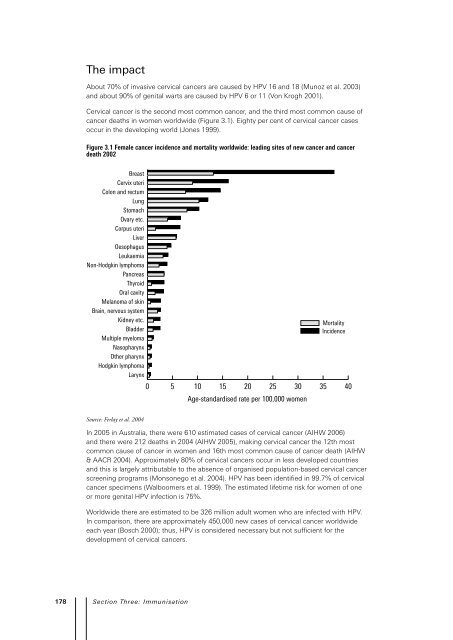National Cancer Prevention Policy - Tobacco Control Supersite
National Cancer Prevention Policy - Tobacco Control Supersite
National Cancer Prevention Policy - Tobacco Control Supersite
Create successful ePaper yourself
Turn your PDF publications into a flip-book with our unique Google optimized e-Paper software.
The impact<br />
About 70% of invasive cervical cancers are caused by HPV 16 and 18 (Munoz et al. 2003)<br />
and about 90% of genital warts are caused by HPV 6 or 11 (Von Krogh 2001).<br />
Cervical cancer is the second most common cancer, and the third most common cause of<br />
cancer deaths in women worldwide (Figure 3.1). Eighty per cent of cervical cancer cases<br />
occur in the developing world (Jones 1999).<br />
Figure 3.1 Female cancer incidence and mortality worldwide: leading sites of new cancer and cancer<br />
death 2002<br />
Breast<br />
Cervix uteri<br />
Colon and rectum<br />
Lung<br />
Stomach<br />
Ovary etc.<br />
Corpus uteri<br />
Liver<br />
Oesophagus<br />
Leukaemia<br />
Non-Hodgkin lymphoma<br />
Pancreas<br />
Thyroid<br />
Oral cavity<br />
Melanoma of skin<br />
Brain, nervous system<br />
Kidney etc.<br />
Bladder<br />
Multiple myeloma<br />
Nasopharynx<br />
Other pharynx<br />
Hodgkin lymphoma<br />
Larynx<br />
Mortality<br />
Incidence<br />
0 5 10 15 20 25 30 35 40<br />
Age-standardised rate per 100,000 women<br />
Source: Ferlay et al. 2004<br />
In 2005 in Australia, there were 610 estimated cases of cervical cancer (AIHW 2006)<br />
and there were 212 deaths in 2004 (AIHW 2005), making cervical cancer the 12th most<br />
common cause of cancer in women and 16th most common cause of cancer death (AIHW<br />
& AACR 2004). Approximately 80% of cervical cancers occur in less developed countries<br />
and this is largely attributable to the absence of organised population-based cervical cancer<br />
screening programs (Monsonego et al. 2004). HPV has been identified in 99.7% of cervical<br />
cancer specimens (Walboomers et al. 1999). The estimated lifetime risk for women of one<br />
or more genital HPV infection is 75%.<br />
Worldwide there are estimated to be 326 million adult women who are infected with HPV.<br />
In comparison, there are approximately 450,000 new cases of cervical cancer worldwide<br />
each year (Bosch 2000); thus, HPV is considered necessary but not sufficient for the<br />
development of cervical cancers.<br />
1 Section Three: Immunisation




